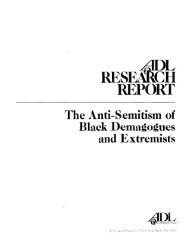Create successful ePaper yourself
Turn your PDF publications into a flip-book with our unique Google optimized e-Paper software.
o<br />
Page 7 of9<br />
information was contradictory. In some cases, Hezbollah, for Instance, was said to be planning direct<br />
attacks against coalition forces. In others, It was said to be working only behind the scenes in fomenting<br />
violence in Iraq.<br />
Perhaps Iran's most significant involvement.ln Iraq has been Its support for Moqtada al-Sadr, the ..<br />
radical, anti-U.S. cleric. His Mahdl Army militia engaged In a series of vicious battles with coalition forces<br />
in the holY.. southern.Shiite cities of Najaf and Karbala, and in the teeming Baghdad slum known as Sadr<br />
City, between-Aprirand.Oetober:thfsqtear. Uke most of Its operations in Iraq, the Intelligence reports<br />
indicate that the Iranian regime has tried to mask Its support of Sadr. He visited Tehran in June 2003 for<br />
a ceremony marking the death of Ayatollah Ruhollah Khomeinl, the spiritual leader of the 1979<br />
revolution, but it is riot known whether he received any commitment from Iran at that time. U.S.<br />
intelligence reports say thatIran used Hezbollah to train and,provlde.funds·to~Sadr·sMahdi:Army'and:<br />
may'also have used front·companies'to~funnel~money:to:him:'l'For-a.time; the·reports=suggest;;Sadr<br />
appeared to be getting funds'from-a"senior-Shiite religious leader living In Iran, the Grand Ayatollah<br />
Kazem al-Haeri, who advocates an Islamic state In Iraq. But by mid-October 2003, according to a special<br />
operations task force, Haeri withdrew his "financial support" from Sadr. The ayatollah later publicly cut<br />
his ties with Sadr. ..<br />
There.was no such break with Hez~ollah•.lhe first sign that the terrorist group planned to support Sadr<br />
is reflected"ln a-July' 29; 2003; U:S: intelligence,report. Citing~Israeli·military-intelligence,-the report says<br />
Hezbollah "military activists" were attempting to establish contacts with Sadr and his Mahdi Army. The<br />
next month they did. By late August, according to a report prepared by aU.S. military analyst, Hezbollah<br />
had established "a team of30 to 40 operatives" in Najaf "In support of Moqtada Sadr's Shia paramiltary<br />
group." The report, based on a source "with direct access to the reported information," said that<br />
Hezbollah was recruiting and training members of Sadr's militia. A later report, citing "multiple sources,"<br />
said that Hezbollah was "buying rocket-propelled grenades ..• antitank missiles" and other weapons for<br />
Sadr's militia.<br />
Intelligence analysts also tied Sadr to Hassan Nasrallah, the secretary general of Hezbollah. "Reporting<br />
also confirms the relationship between •.•• Sadr and Hassan Nasrallah," an Army report said. The report<br />
cited unconfirmed Information indicating that a top adviser to Nasrallah, who Is based In Lebanon, had,<br />
delivered funds to Sadr In Najaf.<br />
Other reporting indicated that the Mahdi Army may have received support from former Saddam<br />
supporters .and other antlcoalition groups. Intelligence analysts were aware, as early as the fall of 2003,<br />
that Sadr could become a serious problem. At that time, there had been no confirmed attacks on<br />
coalition forces, only Sadr's tough rhetoric, in which he denounced the United States and called the Iraqi<br />
Governing Council Illegal. But, as a British defense intelligence report said, "stockpiling of heavier<br />
weapons, along with public antl-CF [Coalition Force] rhetoric, could indicate a willingness to take more<br />
direct action against CF."<br />
"111e honeymoon Is over." Dlrect.action ..was precisely what Sadr took, after Bremer ordered his Baghdad<br />
newspaper shut down, in March this year, accusing It of "inciting violence" against U.S.-led forces. Days<br />
later, after American soldiers arrested a Sadr aide, fierce fighting erupted between U.S. troops and<br />
Sadr's forces. In August, Sadr's Mahdl Army surrendered the Imam All Shrine in Najaf, and last month<br />
he reached a cease-fire with the United States and Iraq's Interim government. Sadr's fighters began<br />
turning in their weapons, as part of an agreement to disband, and Sadr signaled his Intention to get<br />
involved in the political process. He remains influential with many ShIItes, and American officials know<br />
that, if the Iraqi venture is to succeed, they must do everything they can to keep the majority Shiites<br />
happy.~ "Beware if we lose the goodwill of the Shl'ites. The honeymoon is over/' an Army captain wrote in<br />
October 2003, months before the battles with.Sadr's forces began. "Arresting Sadr, the son of a martyr,<br />
will only fuel Shiite extremists' animosity, and strengthen their recruiting efforts."<br />
Managing the Sadr situation, some government and intelligence officials say, is a microcosm of the far<br />
more difficult challenges America faces In responding to Iran's activities in Iraq. Iran clearly has the<br />
potential to stir up far more trouble than it has, partiCUlarly in the largely Shiite southern half of Iraq.<br />
But so far, as It continues its elaborate dance with the West over its ambitious nuclear program, the<br />
Islamic regime has yet to turn the heat up full blast In, Iraq, evidently secure in the knowledge that it can<br />
do so when and· if it sees the need to. "I would not put it past them to carry out spectacular attacks,"<br />
says David Kay, the former chief U.S. weapons inspector in Iraq, "to demonstrate the cost of a hostile<br />
policy. That Is the policy issue--can we learn to live with Iranian nuclear capacity?"<br />
file:I/C:\DO.CUME-l\a~bmJ«at.ll\L9CALS-l\Tell).p\C10~ZFQ~.htm<br />
1Iii6/2004




